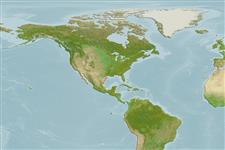>
Zeiformes (Dories) >
Zeniontidae (Armoreye dories)
Etymology: Zenion: Particle zen, derived from zao = to give life .
More on authors: Goode & Bean.
Environment: milieu / climate zone / depth range / distribution range
पारिस्थितिकी
समुद्री बाथीड़िमरसल; गहराई सीमा 180 - 700 m (Ref. 74511). Deep-water; 44°N - 28°S, 98°W - 94°W
Western Indian Ocean: Tanzania and off Delagoa Bay, Mozambique. Western Central Pacific (Ref. 40499). Southeast Pacific: Nazca and Sala-y-Gomez (Ref. 50546). Western Atlantic: Antilles and Venezuela (Ref. 26340). Northwest Atlantic: Canada (Ref. 5951). Eastern Atlantic. South China Sea (Ref.74511).
आकार / वज़न / Age
Maturity: Lm ? range ? - ? cm
Max length : 15.6 cm TL पुल्लिंग / अलिंग; (Ref. 115012); अधिकतम प्रकाशित वज़न: 37.00 g (Ref. 115012)
Short description
पहचान कुंजी | आकृति विज्ञान | मौरफोमैटरिक्स
पृष्ठीय रीढ़ (सम्पूर्ण) : 6 - 7; पृष्ठीय सौफट रेज़ (सम्पूर्ण) : 25 - 28; गुदा कांटा: 1; ऐनल सौफट रेज़: 23 - 28. Body reddish in color (Ref. 4256).
Found over mud or sand-mud bottom (Ref. 26999). Reported to up to 700m depth (Ref. 89996).
Life cycle and mating behavior
Maturities | पुनरुत्पत्ति | Spawnings | Egg(s) | Fecundities | लार्वा
Heemstra, P.C., 1986. Zeniontidae. p. 441. In M.M. Smith and P.C. Heemstra (eds.) Smiths' sea fishes. Springer-Verlag, Berlin. (Ref. 4256)
IUCN Red List Status (Ref. 130435)
Threat to humans
Harmless
Human uses
साधन
Special reports
Download XML
इंटरनेट स्रोत
Estimates based on models
Preferred temperature (Ref.
123201): 10.3 - 12.8, mean 11.4 °C (based on 5 cells).
Phylogenetic diversity index (Ref.
82804): PD
50 = 0.5703 [Uniqueness, from 0.5 = low to 2.0 = high].
Bayesian length-weight: a=0.01230 (0.00468 - 0.03232), b=2.99 (2.77 - 3.21), in cm total length, based on LWR estimates for this (Sub)family-body shape (Ref.
93245).
Trophic level (Ref.
69278): 3.6 ±0.8 se; based on size and trophs of closest relatives
Fishing Vulnerability (Ref.
59153): Low vulnerability (10 of 100).
